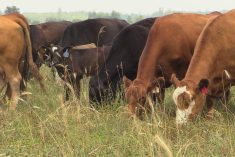Legislating a new framework that regionalizes land-use planning in Alberta will be on the agenda for the provincial government heading into its spring session.
The new Land Stewardship Act and plans to develop a “leading edge” system for capture and storage of atmospheric carbon are listed as the expected “highlights” for the next legislative session, which begins Tuesday afternoon.
The Land Stewardship Act is meant to support implementation of the province’s new Land-use Framework, by setting up seven land-use regions and a Land-use Secretariat, authorizing regional plans, creating regional advisory councils and addressing the “cumulative effects of human and other activity.”
Read Also

U.S. livestock: Cattle regain ground, hogs dip
Chicago cattle futures regained ground on Wednesday after falling off a cliff late last week. Most-active December live cattle contracts…
The purpose of the framework, which was rolled out in draft form last May and developed through 18 months of consultations provincewide, is seen as to manage growth in the province while respecting property rights and municipalities’ decision-making authority.
Among the policies laid out in the framework is a plan to “determine more effective approaches to reduce the fragmentation and conversion of agricultural land.”
That’s a reference to farmland that’s subdivided for country residential development, creating fragmented areas where it can become difficult or dangerous to move ag equipment or cattle along local roads.
As well, in a 2002 report on the topic, the province found it had lost relatively little farmland on a net basis, but said the farmland converted to uses such as residential lots, is often of high capability for annual and horticultural crops. Meanwhile, land being brought into ag production is lower-quality and better suited to forage and pasture.
“Large-scale acquisitions”
On a related topic, and also on the legislature’s agenda for the spring session, is a new Land Assembly Project Area Act that’s meant to “improve the process for government to designate and assemble large tracts of land for major projects such as transportation utility corridors.”
That legislation’s framework is meant to “enhance transparency and accountability when dealing with numerous landowners for large-scale land acquisitions over a long term.”
Other legislation of interest to farmers in the spring session includes:
- the Carbon Capture and Storage Fund Act, which sets up a $2 billion fund committed to grants for “commercial-scale carbon capture and storage” in Alberta;
- the Feeder Associations Guarantee Act, meant to support the growth of feeder associations, implement additional risk mitigation measures for government, and govern a feeder association loan program allowing producer-run co-operatives to obtain financing for members to feed livestock for profit;
- the Marketing of Agricultural Products Amendment Act, which streamlines the process of review and appeals and moves it to a new regulation;
- the Energy Statutes Amendment Act, which is meant to expand an industry-funded program that assumes costs for abandonment and reclamation of orphaned well sites, pipelines or production facilities;
- the Surface Rights Amendment Act, which is expected to enable the province’s Surface Rights Board to implement “more informal, flexible forms of dispute resolution hearings;” and
- the Wildlife Amendment Act, meant to address enforcement, emergency activities such as disease control, and agreements with landholders and disposition holders to protect habitat.















